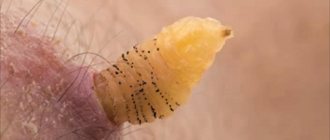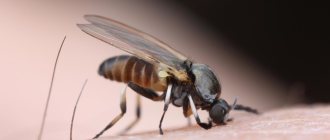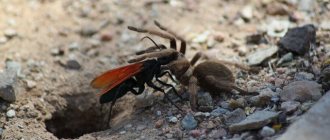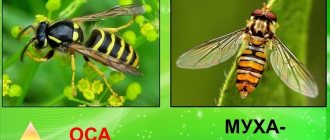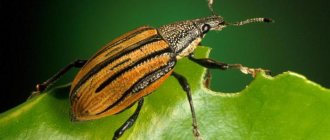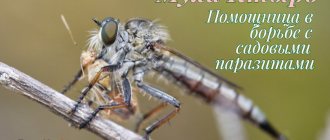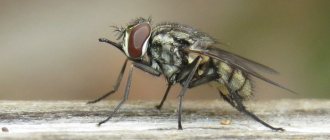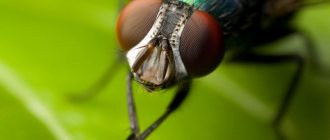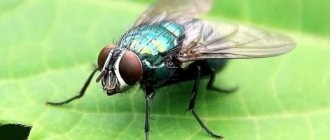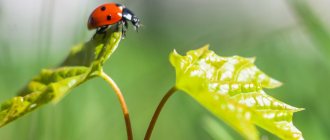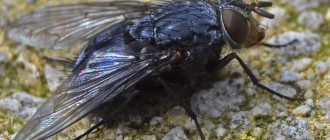The order of Diptera surprises with the variety of representatives. A close relative of the common fly is the ktyr, a ruthless hunter of small and medium-sized insects. A strong body, strong limbs with spikes, a tough proboscis and poison - nature has armed the predator with all this. The moth fly lives all over the world, excluding Antarctica. The exterminator of annoying insects provides a great service to people. But the widespread use of insecticides threatens the existence of beneficial species, some of which are included in the Red Book.
Description
Ktyr is a large family of winged predators. The genus Asilidae belongs to the order Diptera, suborder Short-whiskered. The family of ktyri arose back in the Mesozoic era; today it has more than 7,000 species. A characteristic feature of the structure of the imago is a massive mesothorax and an elongated abdomen. The body shape depends on the species, but in any case it is elongated and cylindrical. Insects living in temperate climates reach a length of 3-50 mm, representatives of tropical species grow up to 80 mm.
The color of the predator is most often black; there are species with brown, reddish or red sclerites. The body is covered with gray pollen; some individuals have a pattern of light stripes and spots. The head is large, almost spherical in shape. Most of its lateral surface is occupied by complex compound eyes. The forehead is depressed, and there are three simple ocelli on the crown. The antennae are shortened. The lower part of the face grows bristles called a beard. They cover the proboscis. This structure helps protect the organ from damage if the victim fights back.
Interesting fact. The head and chest of the ktyri are connected by a movable neck. Some insects can turn their heads 90°.
The strong, developed muscles of the mesothorax provide powerful flight and the ability to capture prey with its limbs. In most species, this part of the body is covered with bristles, hairs and pollen. The wings are well developed, their color varies from transparent to red, brownish and black. The legs are long, massive, covered with bristles. The photo shows that the limbs of the ktyr are adapted by nature to capture and hold prey. Males may have a cluster of contrasting black and white hairs on the fore tibiae.
Biology of hoverflies
Hoverflies, due to the peculiarities of their evolution and similarity with wasps, have spread over most of the globe. They are found everywhere except hot deserts, tundras and, of course, Antarctica. Entomologists count about 6 thousand species of these insects, of which more than 1.5 thousand are found in the Palearctic, 800 in Russia, and 2 species were found even in the subarctic zone.
How to distinguish syrphid from stinging insects
Although the bee fly is similar to wasps and bees, it is absolutely harmless. Below are the signs by which the hoverfly can be distinguished from dangerous insects:
- Syrphid flies are dipterous insects, so the presence of only one pair of wings is the first difference from bees, which have four wings.
- The fly's wings are larger and wider.
- The ability to “hover” in the air and suddenly change direction of flight. This happens thanks to the halteres - a reduced pair of wings.
- A fly has thinner limbs than a bee, and plant pollen does not accumulate on them.
- There are no hard hairs on the body of the hoverfly, but there is fine fluff, like a bumblebee.
- Wasps are non-social insects. Individual individuals live on their own and group only during the mating period.
Reproduction and development
At the end of June, after wintering, an adult wasp fly emerges from the pupa. After mating, females lay eggs and continue to fly until the end of July. Insect eggs develop in the soil near lily and umbrella plants or on the branches of bushes and trees.
A few days later, leech-like larvae up to 1 cm long emerge from the eggs. They have a greenish, pale yellow or pinkish tint. The larvae feed and grow for about a month, after which they pupate. At the end of July - beginning of September, adult flies emerge and lay eggs again. The second generation develops to the pupal stage and goes to winter.
Nutrition
The diet of adult hoverflies, like bees, consists of flower nectar and pollen. Therefore, insects can be found near the flowers of fruit trees, berry bushes and in the garden near umbrella plants.
The larvae, depending on the species, differ in the way they feed. Among them there are vegetarians, predators and saprophages that eat decaying remains. Adherents of plant foods gnaw the stems and bulbs of lilies. Aquatic types of flies dive to the bottom of reservoirs and eat the dendrite. Some exotic representatives of hoverflies will not refuse to feast on dung and decaying wood, while others live in symbiosis with ants, feeding on their reserves.
Predatory larvae are the worst enemies of spider mites, aphids and other small insects, eating not only adults, but also their eggs. It is interesting to watch the larvae hunt for aphids. The leech-like larva crawls along the stems, and when it finds an aphid, it stops and raises the front part of its body (like a snake), swings and attacks its prey. Then the larva sucks out the contents of the aphid's body, leaving only the chitinous shell. In a day, a voracious fly larva can eat several hundred aphids.
Lifestyle
The insect ktyr is known for the habits of an aggressive predator. It feeds on small insects, which it lies in wait for and catches in flight. The fly, called the robber and murderer, can rarely be found carelessly sitting on a branch. If she is not in flight, then she chooses her next victim. The predator's diet includes many types of insects:
- flies;
- dragonflies;
- grasshoppers;
- beetles;
- wasps and bees;
- butterflies.
Ktyr prefers dry places and settles in steppes and meadows. Rarely flies into parks and gardens. Having noticed the prey, he rushes after it. The insect has no chance of escaping from a swift attack. The ktyr kills the caught victim with poison. Its proboscis wounds like a stiletto, and its salivary glands release a potent poison that instantly kills its prey. It contains substances that break down the insides of insects.
The predator can only suck out the nutritious cocktail with its proboscis. Large eyes are also invaluable when searching for food and observing enemies. Predatory birds are divided into several groups depending on hunting areas. They are found everywhere - above the ground, in the grass, above the grass, in the trees.
Attention. A caught roach is very aggressive and can bite a person. The sting of its proboscis is comparable to the sting of a bee.
Reproduction
After fertilization, females lay light-colored eggs up to 2 mm in size. In soil-laying species, the ovipositor has spines and bristles. Females place eggs in various places - on low plants, in crevices of the bark, cracks in the soil. The top of the masonry is covered with special mealy secretions. The larva is white or yellowish, elongated. In the front part of the body there are mandibles (jaws) in the form of hooks. The larva develops in the soil and feeds on rotting organic matter. This is where she pupates.
Killing Fields
Ktyri are found everywhere: from the Arctic tundra to tropical rain forests. Several forest species hunt on foot, setting up ambushes among tree trunks, but most ktyrs can only forage in open, well-lit areas, where it is easy to spot the prey and attack it from the air. To do this, the ktyrs find a viewing position and wait. They usually make their “lair” at the same altitude as the flight path of their prey. Therefore, ideal areas for hunting ktyri are meadows with wildflowers. For sharp-eyed predators, catching prey here is a piece of cake.
Giant ktyr
One of the large species of the family is called the giant blackbird or Satanasgigas. The genus of predatory flies with the eloquent name “Satan” includes insects exceeding 50 mm in size. The length of the giant, despite the name, is quite modest: 28-51 mm. The body is covered with a gray coating, the proboscis is shorter than the head. The larvae develop in the soil; this stage lasts about a year.
Satanasgigas lives in deserts and semi-deserts in northern Africa, Mongolia, Central Asia, Kazakhstan, and southern Europe. Its presence is noted in Ukraine, Russia, Greece. The giant moth was once included in the Red Book of the USSR; now the insect falls under protected status only in Ukraine.
Hover flies
Hoverflies, also known as syrphids, are a large family with about 6,000 species. Some of them look more like bees, others like wasps, and others like bumblebees. They live everywhere, with the exception of Antarctica, desert areas and tundra. They got their name because of the characteristic sound made by their wings.
A striped insect, similar to a wasp, absolutely harmless to humans. It can often be found in plantings of dill, carrots, parsley, and flowering plants in the garden. Adult hoverflies feed exclusively on flower nectar and pollen and occupy an honorable place among pollinating insects
What do hoverfly larvae eat?
Syrphid larvae look like small leeches. They are distinguished by a wrinkled body of yellow or greenish color. They have no legs and are not particularly mobile. They feed on aphids, insect eggs, and spider mites, which bring considerable benefits to agricultural land. A caring mother syrphid lays eggs directly in the aphid habitat.
However, not all hoverfly larvae prefer to see garden pests on their menu. The food preferences of all species are very diverse. Some of them are purely vegetarians and eat only plant tissue. The most exotic representatives process manure or wood.
Complications and consequences
If flies bite in the fall, then their attacks do not cause much concern. As the weather gets colder, the insects will disappear. However, multiple bites provoke allergic reactions and skin diseases. Another thing is the consequences of the bite of a fly such as tsetse. Complications can develop several weeks or months after the pathogen enters the human body.
The specificity of this disease is a long period of development - up to 5 years. After infection with trypanosomes, the first period begins - hematolymphatic. Blood poisoning in tsetse victims is accompanied by fever. The insect bites only once, and this is not enough to cause irreversible changes.
An ataxic gait, tremors of the limbs, and signs of depression indicate a mortal danger to humans. Then a coma develops.
Life cycle
Stages of fly development:
- egg;
- larva;
- chrysalis;
- adult.
The life cycle of a fly begins with an egg. Throughout her life, the female lays 6 or more ovipositions.
Eggs and larvae
Egg development takes from 8 to 50 hours. The flies undergo a complete transformation. After 3-25 days and 3 molts, a fly pupa appears from the larva, which crawls into a cool, dry place.
Within 1.5 days, a sexually mature individual emerges from the pupa.
Some species are viviparous. First instar larvae are produced. This accelerates the development of the pest by 2-3 days.
Emergence of an adult
The most passive stage of a fly's life is its time as a pupa. It is formed when the skin of the larva hardens and becomes the pupal case or puparium.
Inside this case, final transformations occur, implying the disintegration of the larval tissues and the restructuring of its body.
This is the phase of the emergence of an adult (imago), which any person can easily recognize.
How to get rid of bloodsucker
To prevent moose flies from getting on your body, you need to dress properly when going into the forest. There should be no open areas on the body, a jacket, trousers with tight cuffs, and a hat.
When you get home, throw all your clothes in the wash because moose flies may stick to them. Examine the body. If you find a pest, throw it into the fire or a jar of alcohol, then throw it away. Take a shower, wash your hair, comb your hair thoroughly.
Insecticidal repellents are used to protect against deer bloodsucker. Any remedy for ixodid ticks, flies, and fleas is suitable. Effective drugs - Taiga, Raptor, Raid, Off, Cypermethrin 25.
Regarding animals, it is completely impossible to prevent pest attacks, but the timely reaction of the owner and the adoption of emergency measures protect the livestock from serious consequences. Use repellents or folk remedies.
Moose fly bites are treated in the same way as other harmful insects. Wipe the sore spot with ice cubes, medical alcohol, ammonia, aloe juice, and chamomile decoction. Lubricate with Zvezdochka balm and Menovazin. If there is an allergic reaction, take antihistamines and treat sore spots with antiallergic ointments.
Green (carrion)
Despite its partiality to various kinds of carrion and sewage, this fly is a very beautiful insect with a glossy emerald body and translucent smoky wings with a faint openwork pattern. Its body length is about 8 mm. The fly's eyes are large, reddish, its abdomen is round, its cheeks are white. Green flies live mainly in dirty places: on decaying animal corpses, in manure, waste, but sometimes they can be
meet among flowering plants with a strong aroma. They feed on organic rotting matter, where they lay their eggs.
After mating, the female lays about 180 eggs. The egg has a grayish or light yellow tint. She tries to hide them as deep as possible in carrion, where they develop within 6–48 hours to the larval stage. The length of the larvae's body varies between 10–14 mm. After 3–9 days they leave their habitat and move to the soil to pupate. The pupal stage lasts from 10 to 17 days (depending on weather conditions), after which the insect emerges to the surface as an adult fly.
Necrophages
Necrophagous flies
Fly species names can often be misleading. Such a species as the “dust fly” does not exist in nature. This name most often hides lucilia, which belongs to the group of necrophages. In the garbage dumps themselves, you can find any synanthropic species, including fruit flies. The group of necrophagous flies of the most famous flies includes:
- Lucilia (green);
- gray meat;
- blue meat
They all feed on animal carcasses, but also include food scraps, plant juices and excrement in their diet.
Lucilia
A very common and well-known emerald green fly, capable of laying eggs on meat left unattended for a couple of minutes.
They often lay eggs in open wounds, where larvae begin to develop by eating rotting flesh. The main habitat of these dipterans near human habitation is slaughterhouses. But larvae can also develop in animal excrement. It takes 1-2 days for the larvae to develop from the egg.
Blue meat
Medium sized insect. Distributed across all continents. Like the green one, it prefers slaughterhouses and decaying meat.
Pest flies that live nearby
Melon fly
Among the insects there are garden pests: melon fly, raspberry fly, cherry fly, onion fly and cabbage fly. They should not be confused with Drosophila fruit flies, which, although they are close relatives, do not cause direct harm, as they feed on rotten fruits and berries.
But let's return to garden pests. As you might guess, the cherry fly parasitizes cherries, the melon fly can destroy the harvest of honey-sweet fruits, and the raspberry fly attacks one of the healthiest berries. Onion larvae will eat the entire root crop. The cabbage fly is not particularly discerning and eats all cruciferous vegetables. The arrival of such pests in the garden is a real disaster. Adult insects feed on liquid food, but the larvae feed on the fruits in which the females deposit them. If you notice insects circling over the beds and garden trees, slightly smaller than ordinary flies, but very similar to them, immediately destroy them, otherwise the crop will be destroyed!
Cabbage fly
The cabbage fly eats cruciferous vegetables, including wild ones. Its invasion is especially dangerous for the garden due to its widespread distribution. The cabbage fly is one of the most voracious parasites on vegetable crops.
Hessian fly
Another pest that is dangerous on a larger scale is called the Hessian fly. Its larvae feed on cereals, preferring wheat and rye. The Hessian fly is more like a mosquito; it is not without reason that it is called the “bread mosquito.” According to legend, it came to our country with fodder brought by Hessian mercenaries back in 1776. It has taken root, become familiar, and causes enormous damage to domestic agriculture. The Hessian fly is dangerous because if the attack is not stopped in time, it can easily ruin the entire cereal harvest.
The forest pest is the fungus fly. Her children are the worms we all know, hopelessly spoiling boletus, boletus, russula, etc.
These insects are harmful and dangerous, but there are even worse ones. Let's get to know the bloodthirsty flies that bite.
Ktyri
Slender, predatory flies are quite large in size. The body and limbs are covered with a thick layer of short hairs. For humans, blackflies do not pose any danger, but insects such as mosquitoes, midges, beetles and even bees are quite rightly
they are afraid.
Ktyrs obtain food by hunting in the air, clutching the caught prey with their tenacious long paws. After this, they stick their sting into the defenseless body to inject poison into it and calmly suck out the contents. Sometimes another ktyr can become the prey of a ktyr.
This predatory fly brings great benefits to humanity, killing and eating many different dangerous insects. The larvae of moths are also predators. They live in rotten wood, soil and other rotting matter, where their food is various small insects and other larvae.
Benefits and harms
Hoverflies can be classified as predatory insects, as they feed on plant foods and insect pests. Adults feed on pollen and plant nectar. Therefore, hover flies can be classified as pollinating insects. Insects give the greatest preference to umbelliferous and asteraceous plants. They do not disdain a variety of meadow grasses, fruit trees and shrubs.
The basis of insect nutrition is sugar, which is contained in nectar. It is he who gives the hoverflies energy. And pollen provides the protein necessary for the growth and development of eggs.
The hatched larvae differ in their feeding habits. Some feed on rotting wood, while others live and develop in water. There are exotic species that eat and process manure. Most of the larvae prefer aphids. Therefore, they can be considered true protectors of gardens. Many amateur gardeners specially plant the trunk circles of berry and fruit trees with umbrella crops in order to attract hoverflies to the garden to prevent aphid attacks.
But there are varieties of hover flies that feed on lily crops. It is these specimens that can cause damage to the crop by eating the bulbs of flower crops and damaging onions and garlic.
An interesting insect is the hoverfly. Despite the fact that some species can eat cultivated plants, in general they are assistants to humans. In remote mountainous areas, where there is a shortage of bees and wasps, they pollinate plants and increase their productivity. Great help is provided by eating aphids and spider mites in the garden. This protects the trees from pests. And it’s just interesting to watch them move in the air.
